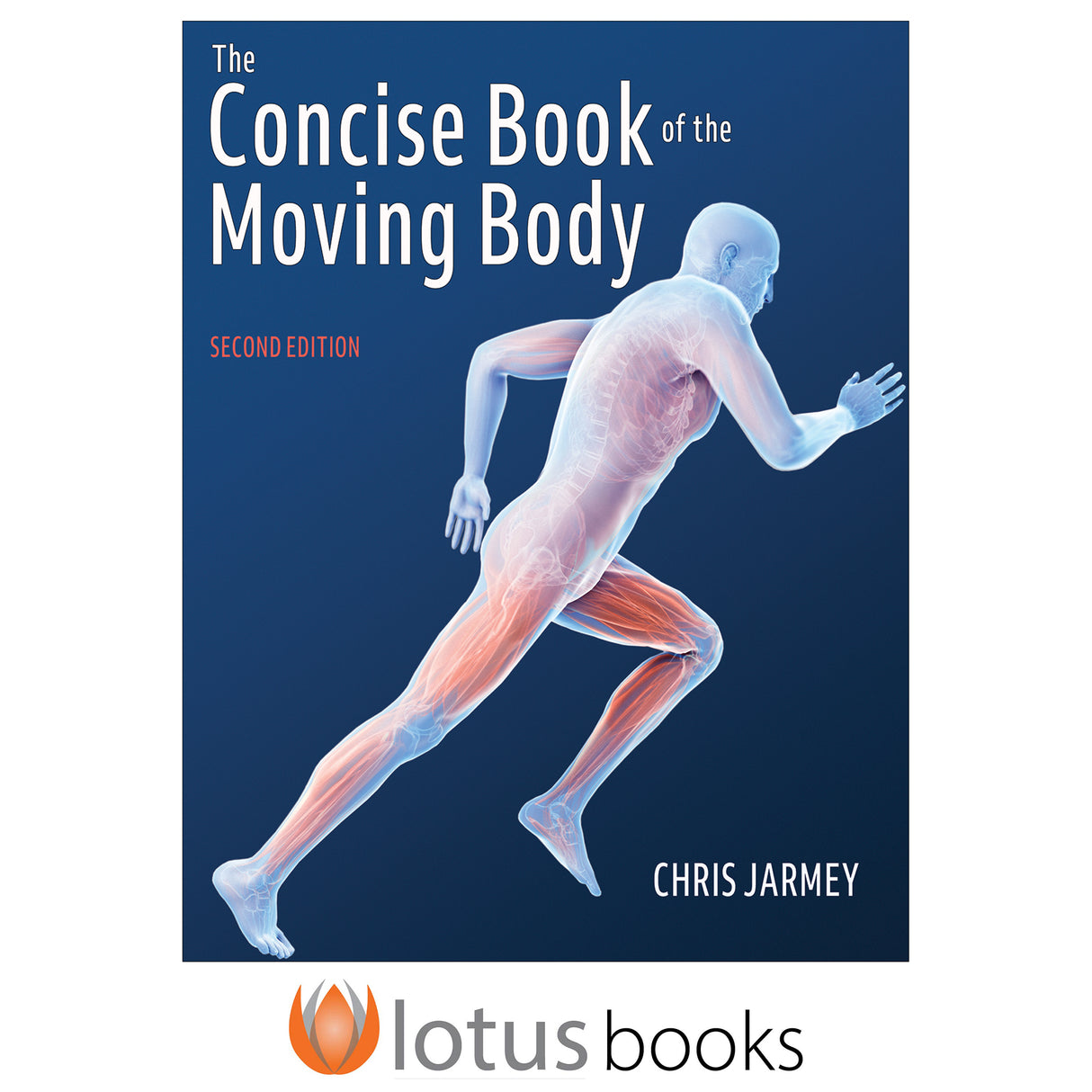Paperback
The Concise Book of the Moving Body-2nd Edition
Author: Chris Jarmey
$34.95 CAD
Unit price
/
Unavailable
Paperback
$34.95 CAD
$34.95 CAD
Paperback
Explore the musculoskeletal system, joints, and nerves with full-color illustrations.
The Concise Book of the Moving Body, Second Edition, details human anatomy, including the musculoskeletal system, joints, nerves, and everyday movements. The text is fully illustrated, with more than 500 full-color drawings, making it a perfect resource for movement-oriented therapists, students, and athletes.
The Concise Book of the Moving Body is broken down into nine easily digestible chapters, covering anatomical terms, tissues, bones, the axial and appendicular skeletons, joints, peripheral nerve supply, the musculoskeletal system, and the musculoskeletal system in everyday life. In addition to anatomical illustrations, color tables list each muscle's origin, insertion, nerve, and action.
The second edition has been updated with the addition of two new chapters. Chapter 7 focuses on the peripheral nervous system. Throughout the chapter, the relevant somatic peripheral nerve is listed with each muscle. In addition to nerve origin, the clinical significance of important nerves is explained.
Chapter 9 addresses the functional musculoskeletal system, focusing on the anatomy that controls basic movements required for everyday activities, such as sitting, standing, walking, and running.
While designed for the student and beginning practitioner of anatomy, massage, bodywork, physical therapy, chiropractic medicine, physiotherapy, yoga, and Pilates, this second edition of The Concise Book of the Moving Body is equally useful for athletes and anyone interested in the workings of the human body.
The Concise Book of the Moving Body, Second Edition, details human anatomy, including the musculoskeletal system, joints, nerves, and everyday movements. The text is fully illustrated, with more than 500 full-color drawings, making it a perfect resource for movement-oriented therapists, students, and athletes.
The Concise Book of the Moving Body is broken down into nine easily digestible chapters, covering anatomical terms, tissues, bones, the axial and appendicular skeletons, joints, peripheral nerve supply, the musculoskeletal system, and the musculoskeletal system in everyday life. In addition to anatomical illustrations, color tables list each muscle's origin, insertion, nerve, and action.
The second edition has been updated with the addition of two new chapters. Chapter 7 focuses on the peripheral nervous system. Throughout the chapter, the relevant somatic peripheral nerve is listed with each muscle. In addition to nerve origin, the clinical significance of important nerves is explained.
Chapter 9 addresses the functional musculoskeletal system, focusing on the anatomy that controls basic movements required for everyday activities, such as sitting, standing, walking, and running.
While designed for the student and beginning practitioner of anatomy, massage, bodywork, physical therapy, chiropractic medicine, physiotherapy, yoga, and Pilates, this second edition of The Concise Book of the Moving Body is equally useful for athletes and anyone interested in the workings of the human body.
Audience
Students and practitioners of anatomy, massage, bodywork, physical therapy, physiotherapy, chiropractic medicine, yoga, and Pilates. Chapter 1. Anatomical Terms
Positions
Planes
Regions
Movements
Chapter 2. Tissues
Connective Tissue
Muscle Tissue
Chapter 3. Bones
Bone Development and Growth
Cartilage
Functions of Bones
Types of Bone—According to Density
Types of Bone—According to Shape
Components of a Long Bone
Bone Markings
Chapter 4. The Axial Skeleton
The Skull, Comprising the Cranium and the Facial Bones
The Vertebral Column (Spine)
The Bony Thorax
Chapter 5. The Appendicular Skeleton
The Pectoral Girdle
The Upper Limb
The Pelvic Girdle (Os Innominatum)
The Lower Limb
General Skeletal Interrelationships
Bony Landmarks Seen or Felt Near the Body Surface
Chapter 6. Joints
Part One—Classification of Joints
Part Two—Features of Specific Joints
Joints of the Head and Vertebral Column
Joints of the Ribs and Sternum
Joints of the Shoulder Girdle and Upper Limb
Joints of the Pelvic Girdle and Lower Limb
Chapter 7. Peripheral Nerve Supply
Cranial Nerves
Cervical Plexus
Brachial Plexus
Lumbosacral Plexus
Lumbar Plexus
Sacral Plexus
Chapter 8. The Musculoskeletal System
Structure and Function of Skeletal Muscle
Musculoskeletal Mechanics
Muscle Library
Chapter 9. The Musculoskeletal System in Everyday Life
Introduction
Sitting Down
Sitting to Standing
Standing Upright
Walking
Walking up Stairs
Running and Sprinting
References
Positions
Planes
Regions
Movements
Chapter 2. Tissues
Connective Tissue
Muscle Tissue
Chapter 3. Bones
Bone Development and Growth
Cartilage
Functions of Bones
Types of Bone—According to Density
Types of Bone—According to Shape
Components of a Long Bone
Bone Markings
Chapter 4. The Axial Skeleton
The Skull, Comprising the Cranium and the Facial Bones
The Vertebral Column (Spine)
The Bony Thorax
Chapter 5. The Appendicular Skeleton
The Pectoral Girdle
The Upper Limb
The Pelvic Girdle (Os Innominatum)
The Lower Limb
General Skeletal Interrelationships
Bony Landmarks Seen or Felt Near the Body Surface
Chapter 6. Joints
Part One—Classification of Joints
Part Two—Features of Specific Joints
Joints of the Head and Vertebral Column
Joints of the Ribs and Sternum
Joints of the Shoulder Girdle and Upper Limb
Joints of the Pelvic Girdle and Lower Limb
Chapter 7. Peripheral Nerve Supply
Cranial Nerves
Cervical Plexus
Brachial Plexus
Lumbosacral Plexus
Lumbar Plexus
Sacral Plexus
Chapter 8. The Musculoskeletal System
Structure and Function of Skeletal Muscle
Musculoskeletal Mechanics
Muscle Library
Chapter 9. The Musculoskeletal System in Everyday Life
Introduction
Sitting Down
Sitting to Standing
Standing Upright
Walking
Walking up Stairs
Running and Sprinting
References









